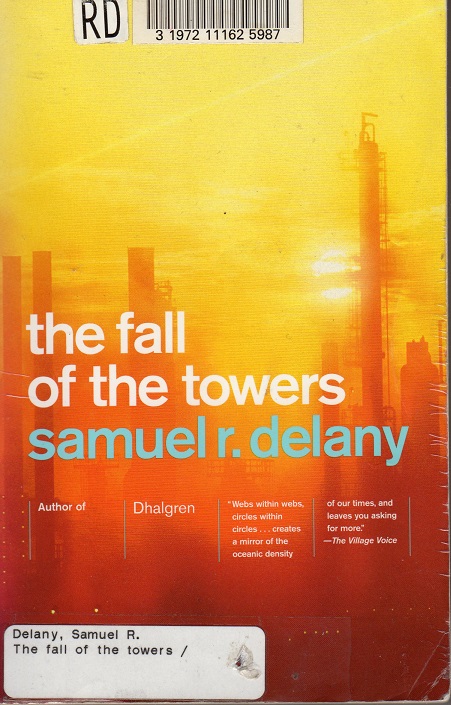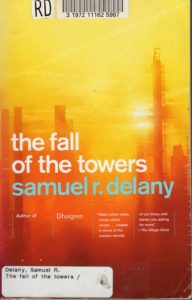Book Review: The Fall of the Towers by Samuel R. Delany
Five hundred years after the old civilizations perished in the Great Fire, the Toromon Empire occupies all the known livable space on Earth. But they are hemmed in by deadly radioactive belts and there’s nowhere for it to grow. And yet–and yet, the Empire is not alone and there is something beyond the barrier…is it the enemy the Toromon government claims?
This science fiction trilogy is an early work by noted author Samuel R. Delany. I have previously reviewed the first part, Out of the Dead City and it would be best if you read that review first. To briefly recap, escaped prisoner Jon Koshar, the Duchess of Petra, and scarred giant Arkor are contacted by a disembodied intelligence called the Triple Being to battle another disembodied intelligence, The Lord of the Flames, which is interfering with humanity. This is set against a backdrop of the Empire preparing for war with its unknown enemy.
The Towers of Toron: It has been three years since the climax of the previous volume. The war with the enemy beyond the barrier is in full swing, although it is impossible to tell how well it is doing, as none of the soldiers ever return. The Lord of the Flames has returned to Earth, and must be rooted out again regardless of the cost.
The emphasis shifts somewhat in this volume, with two previously minor characters taking on new importance. Clea Koshar, physicist and math genius (and Jon’s sister) is in hiding. She is suffering what we would now call PTSD due to her war work, and is triggered by a common patriotic phrase, so has holed up in a boarding house under an assumed name and tries to avoid interacting with anyone. Towards the end of the book, she begins to heal with the aid of circus acrobat Alter.
Runaway fisherman’s son Tel joins the army and is sent into the war. Anyone who’s ever been through basic training (and quite a few who haven’t) will recognize that the training sequences don’t make any sense–which is only the first clue that something is very wrong here. Once Tel is in the war itself, it turns out to be a murky affair, mists constantly concealing everything even a few feet away, constantly repairing machinery of unclear purpose, and random lethal attacks by an enemy that is never actually seen.
While banishing The Lord of the Flames is a necessary thing, it is not sufficient to stop the war. That will take an unprecedented act of communication and understanding.
The City of a Thousand Suns: A month after the events of the previous book, the war appears to be over, but one of the participants hasn’t put down their arms, and the consequences of the war are coming home to the island of Toron, where the Toromon Empire is centered.
On another front, actions taken by the Triple Being earlier in the trilogy have left their agents susceptible to influence by The Lord of the Flames, which is starting its endgame, to learn how to make war against the universe. The Earthlings must finish their final mission without the direct aid of their sponsors. That mission: collect three books that represent the finest thinking of humankind.
One of the authors comes directly on stage for the first time in the trilogy: poet Vol Nonik. He’s finally gotten out of the street gang he was in, but former rival gang leader Jeof still holds a grudge. He and his minions attack Vol and his artist wife Renna, crippling the poet and murdering the woman. This tips Vol Nonik over the edge into despair..which is good for his poetry…maybe? He’s not so sure.
This volume is heavy on the Big Ideas as it wraps up the themes of the trilogy. Creating new perceptions by forcibly moving a person from one setting to another, the question of whether it’s better to fix sick social systems or just let them go smash, and of course, the meaning of life. One of the recurring images is the gambling game Randomax, which appears as random as the name suggests, but is actually easily manipulated by those with higher math skills.
There’s more sexism as the trilogy continues, less, I think, from the author himself than from the social assumptions he’s working with. There’s also a fair amount of “fantastic racism” as prejudice against the Neo-Neanderthals and the gigantic forest guards comes up every so often, and within the forest guard culture, how they treat their telepathic minority.
The closing chapters become clumsy, with hallucinatory paragraphs meant to show a poet plunging into suicidal madness, and a huge infodump by the Triple Being to explain what The Lord of the Flames really is and how it was working behind the scenes of the final book. The Lord never becomes a character in its own right, and we will just have to accept the Being’s word that it is no longer a threat.
But then there is the city of a thousand suns, and perhaps there is hope for the future after all.
Recommended for Delany fans and those interested in the roots of New Wave science fiction.


